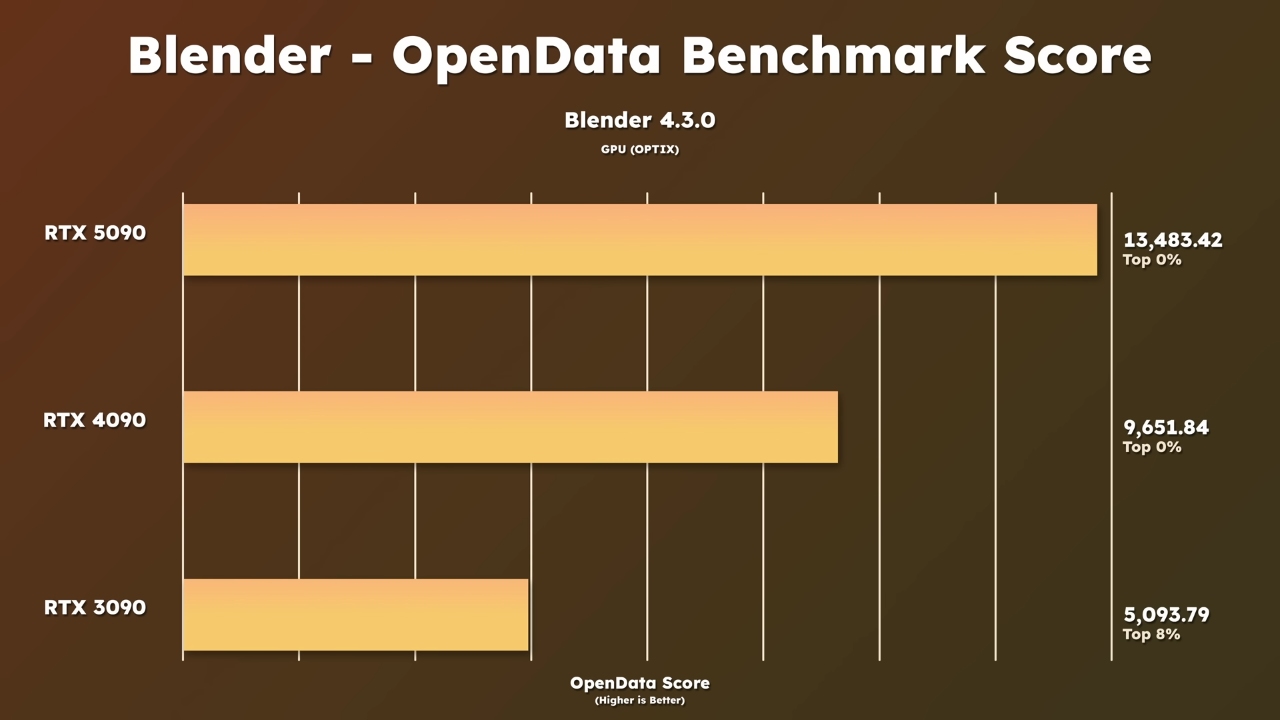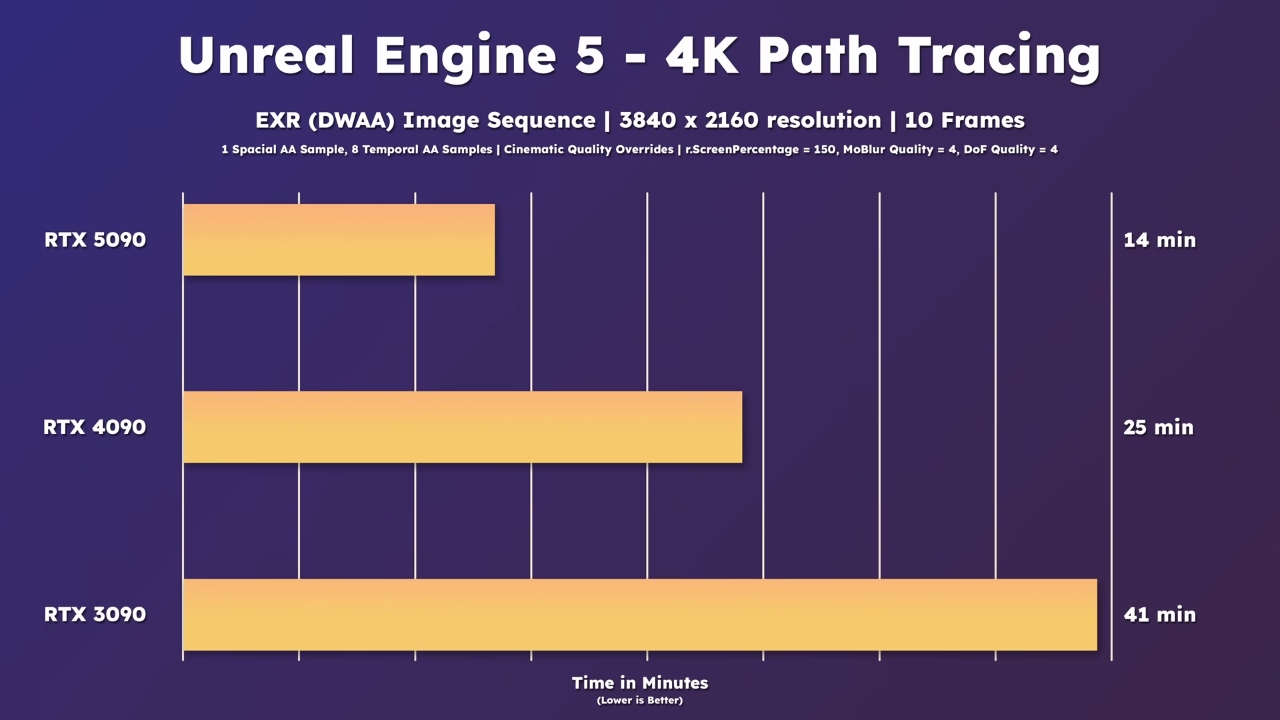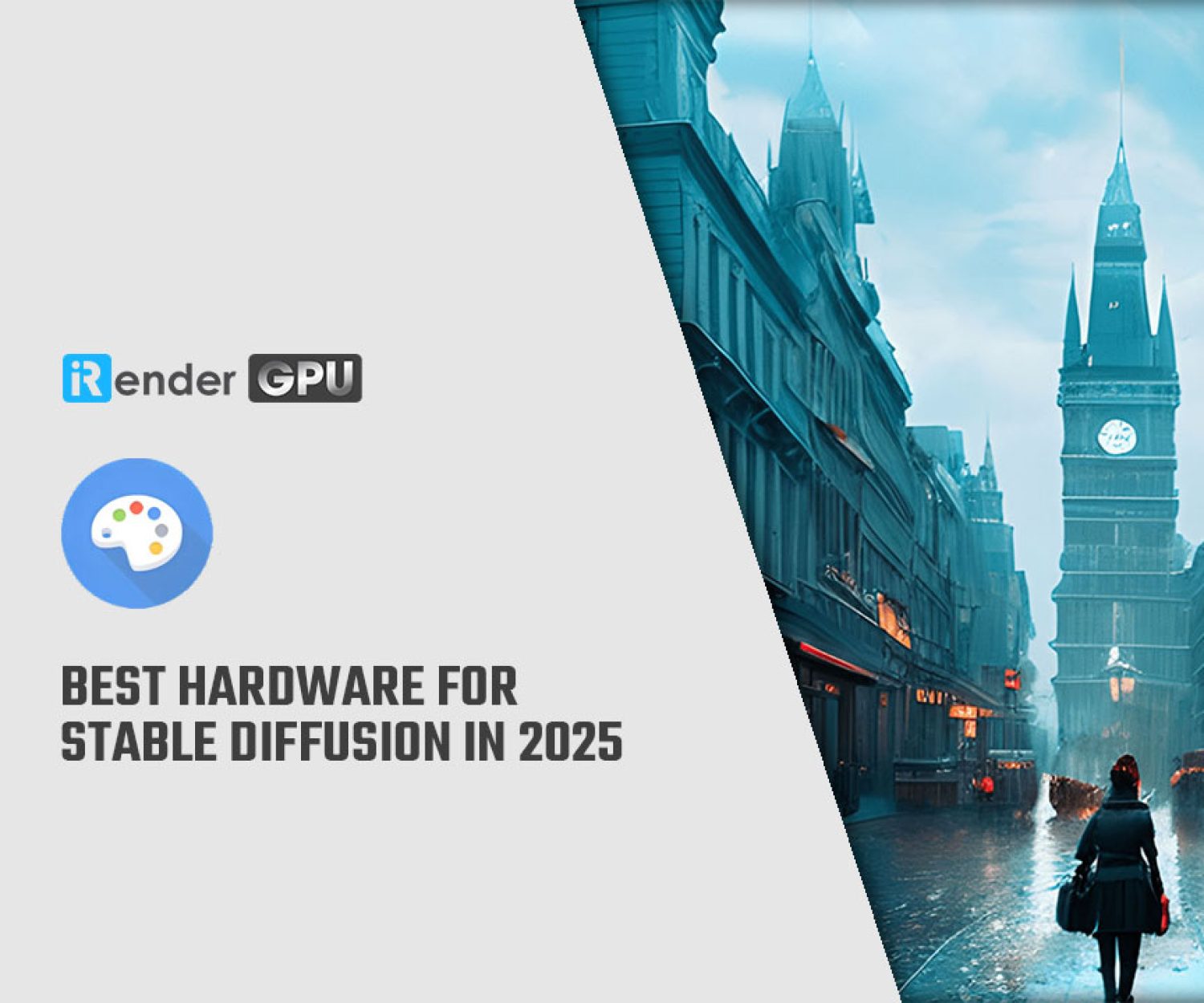RTX 5090 vs 4090: Which Is Best for 3D Rendering in 2025?
With the arrival of NVIDIA’s next-gen RTX 5090 GPU, 3D artists and studios are eager to know how it stacks up against the powerhouse RTX 4090. Is it worth upgrading to render tasks in Blender, Unreal Engine, Maya, or V-Ray? Or should you stick with the tried-and-tested 4090? We’re tired of gaming benchmark videos, so in this article, we’ll take a deep dive into a comprehensive comparison between the RTX 5090 vs RTX 4090, covering performance benchmarks, architectural differences, price/value analysis, and real-world rendering tests to determine the best GPU for 3D rendering in 2025.
There is a lot to cover, so let’s get started!
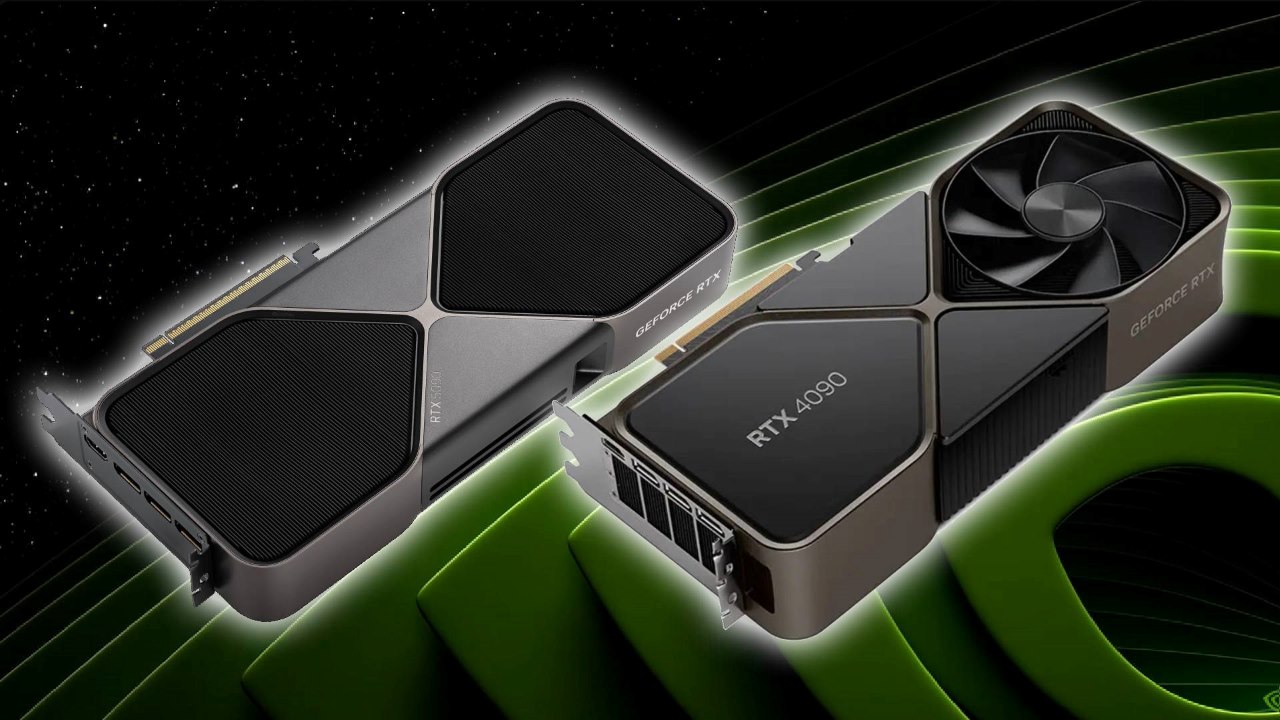
Image source: gamesradar.com
RTX 5090 vs 4090: Technology Overview and Comparison
Both RTX 5090 and RTX 4090 are NVIDIA’s flagship GPUs, built to meet the needs of high-end gamers and creative professionals. However, the RTX 5090 introduces some notable upgrades over the previous generation, especially in terms of performance and workload handling.
|
Specifications |
RTX 5090 |
RTX 4090 |
|
NVIDIA Architecture |
Blackwell |
Ada Lovelace |
|
Manufaturing |
TSMC 4N |
TSMC 4N |
|
DLSS |
DLSS 4 |
DLSS 3 |
|
CUDA Cores |
21760 |
16384 |
|
Clock Speed |
2010 – 2410 MHz |
2235 – 2520 MHz |
|
TDP |
575W |
450W |
|
AI TOPS |
3352 |
1321 |
|
Tensor Cores |
5th Gen |
4th Gen |
|
Ray Tracing Cores |
4th Gen |
3rd Gen |
|
NVIDIA Encoder (NVENC) |
3x 9th Gen |
2x 8th Gen |
|
NVIDIA Decoder (NVDEC) |
2x 6th Gen |
1x 5th Gen |
|
Memory Configuration |
32 GBGDDR7 |
24 GBGDDR6X |
|
Memory Bandwidth |
1792 GB/sec |
1008 GB/sec |
|
Release Date |
Jan 2025 |
Oct 2022 |
|
Launch Price |
$1999 |
$1599 |
In terms of raw specs, RTX 5090 features the new Blackwell architecture with a host of cutting-edge technologies, and it’s no surprise that it outperforms the RTX 4090. First, DLSS 4 is said to deliver up to 8x better FPS. Just hearing about it is enough to see how much the Frame Generation technology has improved. Overall, the total increase in the number of cores or texture units will be about 33% higher than the previous generation.
In terms of clock speed, RTX 4090 has a Boost Clock of 2520 MHz compared to 2407 MHz on the RTX 5090. This means that RTX 5090 is only about 27% more “optimized” than the 4090 when both use the same architecture for comparison.This year’s RTX 50 generation also shows that NVIDIA has been more “generous” with VRAM. In terms of capacity, speed, and bandwidth, the RTX 5090 is superior, with 33% more VRAM and 33% improved clock speed compared to the RTX 4090. Especially at a time when AI is on the rise like today, 32GB of VRAM on the 5090 will be a good condition to use AI features.
Price and Value Analysis
When it comes to RTX 5090 vs 4090 pricing, we want you to know how the prices of the best NVIDIA graphics cards have changed over the years.
The MSRP of RTX 5090 is listed as $1,999 / £1,939 / AU$ 4,039 for Nvidia’s Founders Edition cards. And $1,599 / £1,679 / AU$ 2,959 for RTX 4090 Founders Edition cards, which are due for release in October 2022.
However, RTX 4090 is selling for 50% more. Of course, the price also depends on the card and the seller (not to mention the MSRP of cards from NVIDIA partners like PNY, MSI, Asus, Gigabyte, and more). The RTX 4090 has risen above $2,000/£2,000/AU$ 4,000 and has remained there since launch.
Furthermore, while RTX 5090 and 4090 appear to be selling for the same price, the RTX 5090 will be subject to similar price pressure. Additionally, the RTX 5090 is experiencing shortages, which will drive up the price even further.
So RTX 5090 will still end up being more expensive than the RTX 4090, and a lot more expensive. With the RTX 4090 also no longer in production, buying either one is a bit more of a chore.
Render Configuration Comparison
Compared to RTX 4090, RTX 5090 offers a more capable setup for heavy rendering tasks thanks to its larger 32GB VRAM and faster memory bandwidth. While the 4090’s 24GB is still excellent for most workflows, complex scenes with high-res textures or simulations can easily benefit from the extra capacity.
The 5090’s GDDR7 memory and improved thermal design also make it better suited for multi-GPU configurations, reducing bottlenecks during long renders. For demanding pipelines in Blender, Maya, or V-Ray, the 5090 simply scales better and delivers more consistent performance under load.
Design and Cooling
| RTX 5090 – 2-Slot Design (48mm) | RTX 4090 – 3-Slot Design (61mm) | |
| Dimensions | 304mm × 137mm | 304mm × 137mm |
| Peak Temp | 77°C under load | 68°C under load |
| Cooling | Vapor Chamber, Liquid Metal TIM | Standard Vapor Chamber |
| Case Compatibility | Excellent (SFF friendly) | Limited (many exclusions) |
RTX 5090 uses more power than the 4090, around 575W compared to 450W, a 28% increase. For this reason, NVIDIA recommends a PSU of at least 1,000W, but many experts recommend going up to 1,200W if you’re using a powerful CPU or multiple components.
Even with the higher power draw, the 5090 Founders Edition stays cool thanks to its improved cooling system. It uses a new dual-axis cooler with a 3D vapor chamber and liquid metal for better heat transfer.
In the tests, RTX 5090 ran at around 77°C under full load, which is slightly higher than the 4090’s 68°C but still perfectly safe. The fan system is designed to be quiet, typically only reaching 48% of its maximum speed under normal use.
Interestingly, despite using more power, the 5090 actually runs much quieter than the 4090 cards because the fan design allows for smoother airflow with less turbulence.
RTX 5090 vs 4090: Rendering Performance Comparison
Now, given its new architecture, we can expect RTX 5090 to outperform 4090 in rendering tasks. So, let’s see their real-world rendering performance across popular software like Blender, Unreal Engine, Maya Arnold, and Davinci Resolve!
Blender
Blender benchmark score from Sir Wade Neistadt
When comparing the performance of RTX 5090 vs RTX 4090 in Blender 4.3, two key metrics highlight their differences: synthetic benchmark scores and real-world rendering performance. In the Blender OpenData benchmark using OptiX, the RTX 5090 scored 13,483.42, about 40% higher than the RTX 4090’s 9,651.84, showcasing its superior theoretical power.
However, in a real-world 4K Cycles animation render test (58 frames at 3840×2160), the RTX 5090 took 32 minutes to complete the task, while the RTX 4090 finished in just 28 minutes. This suggests that despite its stronger specs, the RTX 5090 may not yet be fully optimized for certain Blender workloads.
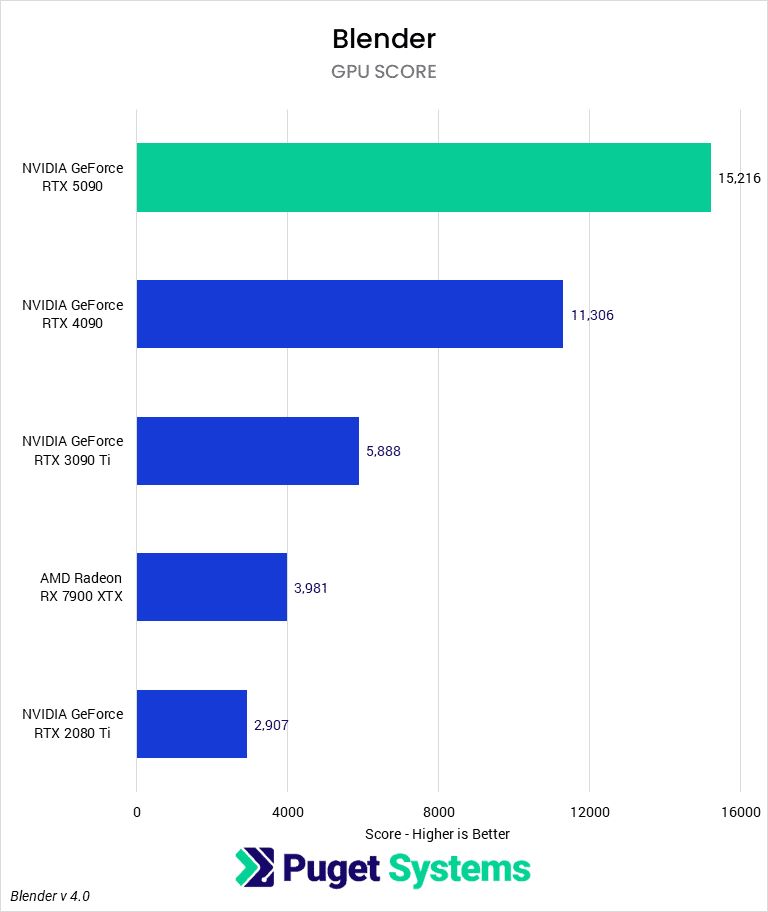
Blender benchmark score Puget Systems
On another hand, in Puget Systems’s benchmark score, for GPU-based offline rendering, the RTX 5090 manages a 35% performance advantage over the 4090. This is a significant improvement that users can consider.
But overall, the RTX 4090 is still the more efficient and cost-effective choice for practical Blender rendering tasks at this time.
Unreal Engine
Unreal Engine benchmark score from Sir Wade Neistadt
In terms of RTX 5090 vs 4090 in Unreal Engine 5 workloads, the results vary depending on the rendering method. In the 4K Native Renderer test (696 frames), both GPUs completed the task in 9 minutes, showing nearly identical performance. However, in the more demanding 4K Path Tracing test (10 frames), the RTX 5090 clearly outperformed the 4090, completing in just 14 minutes compared to 25 minutes. This marks a 44% improvement in render time for the 5090. Meanwhile, the RTX 3090 fell far behind in both tests, taking 23 and 41 minutes, respectively.
These results show that while the RTX 5090 doesn’t offer much of an advantage in well-optimized raster workloads, it does have a significant advantage in heavy ray tracing scenarios. For users working with cinematic quality visuals in Unreal Engine 5, especially with regards to Path Tracing, the 5090 is a significantly more powerful choice.
Maya Arnold
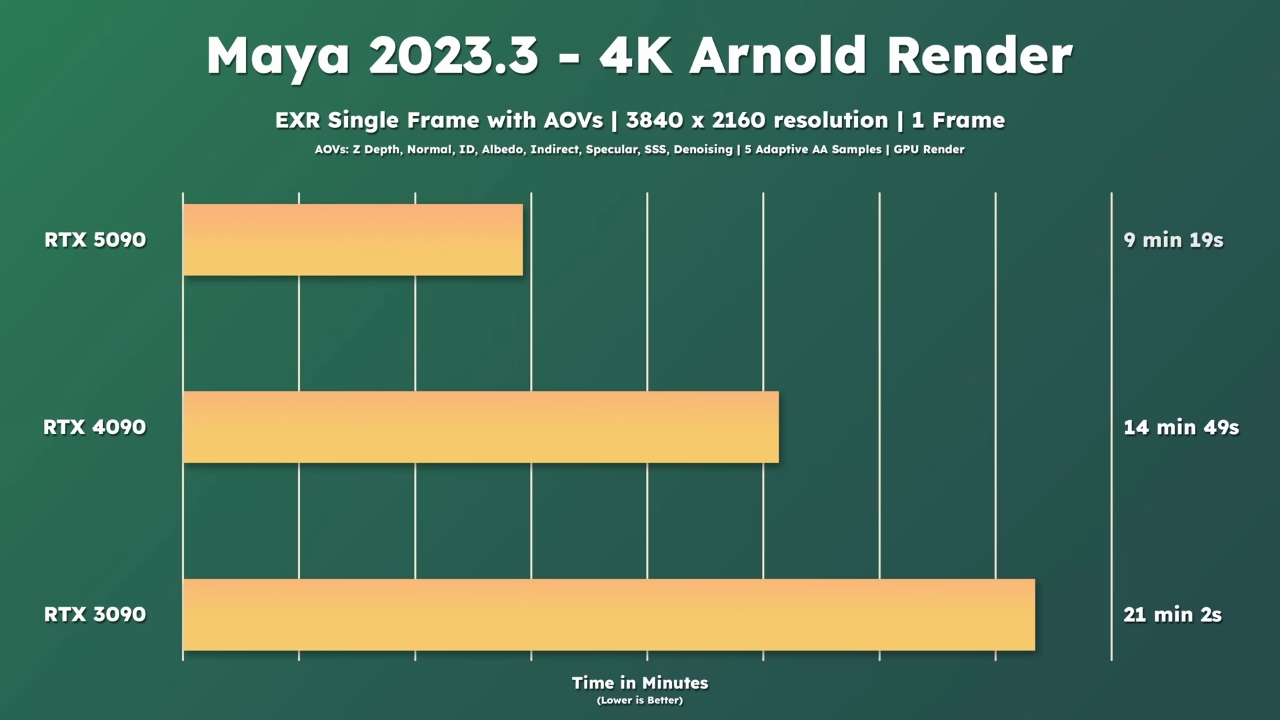
Maya Arnold benchmark score from Sir Wade Neistadt
In the Maya 2023.3 4K Arnold rendering test, the RTX 5090 clearly outperformed its predecessors. Rendering a single frame with full AOV at 3840×2160 resolution, the 5090 completed the task in just 9 minutes and 19 seconds. For comparison, the RTX 4090 took 14 minutes and 49 seconds, while the RTX 3090 lagged behind at 21 minutes and 2 seconds. This represents a 37% improvement over the 4090 and nearly 56% improvement over the 3090. This big difference of 3090 is due to its VRAM capabilities.
The test, which includes complex elements like subsurface scattering, denoising, and multiple render passes, highlights the 5090’s prowess in handling demanding GPU-based workflows. For artists and studios that rely on Arnold for cinematic-quality rendering, the RTX 5090 stands out as a significant time-saving upgrade.
V-Ray
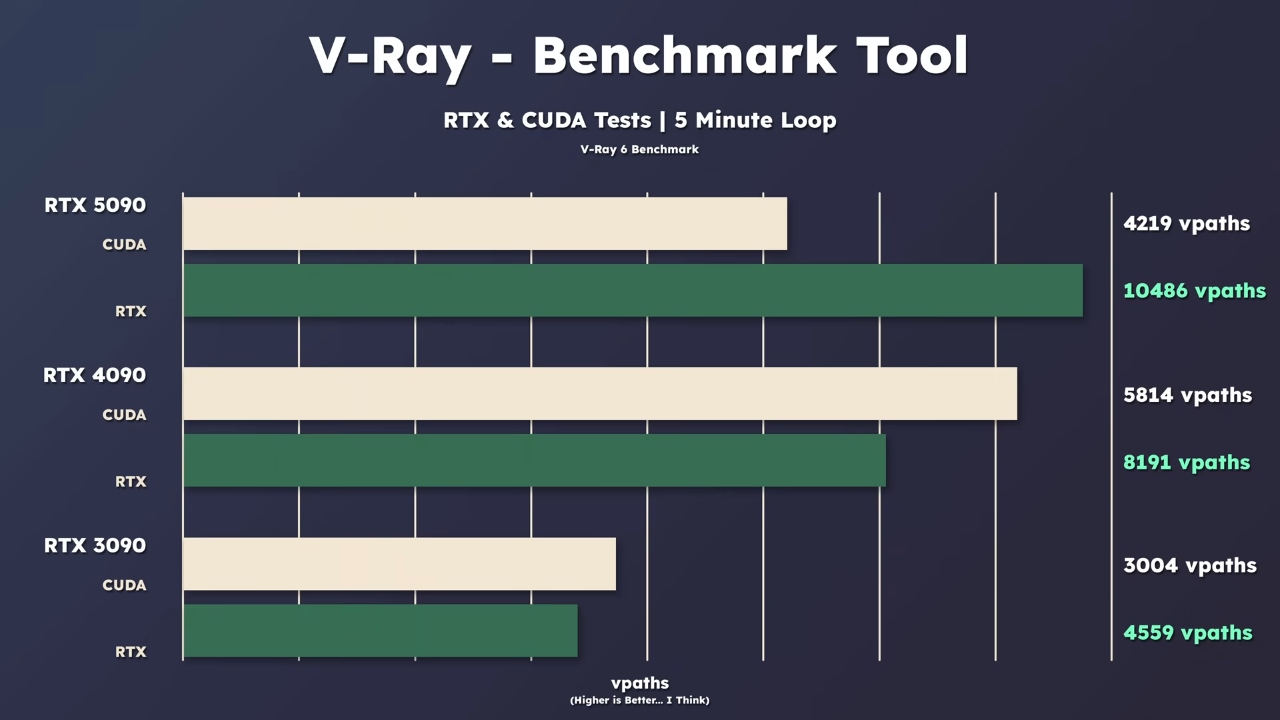
V-Ray benchmark score from Sir Wade Neistadt
In the V-Ray 6 benchmark, RTX 5090 delivered impressive performance in RTX rendering, but fell slightly behind the 4090 in CUDA-based tasks. Specifically, the 5090 scored 10,486 vpaths in the RTX test, beating the 4090’s 8,191 vpaths by about 28% and more than doubling the 3090’s 4,559 vpaths. This highlights the 5090’s strength in ray tracing workloads like architectural visualization and cinematic lighting.
However, in the CUDA benchmark, the 5090 scored 4,219 vpaths, significantly lower than the 4090’s 5,814, likely due to software or driver optimizations.
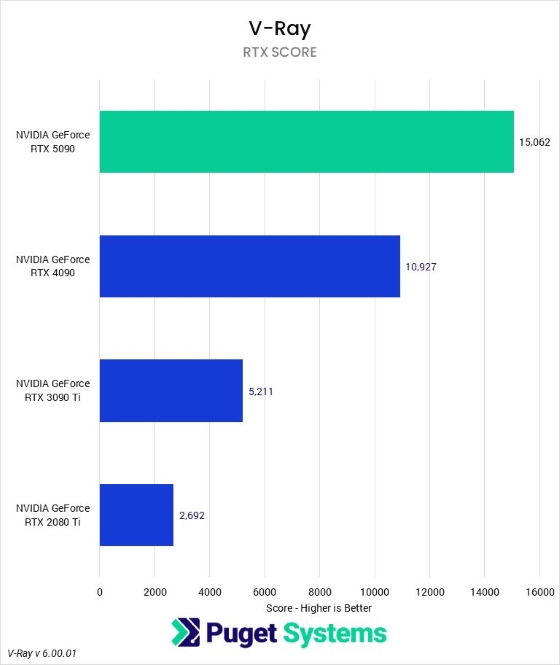
V-Ray benchmark score Puget Systems
This chart from Puget Systems illustrates RTX rendering performance in V-Ray 6.00.01 across four NVIDIA GPUs. The RTX 5090 leads by a significant margin, scoring 15,062, about 38% faster than the RTX 4090 (10,927). This dramatic performance increase highlights the architectural and hardware improvements in the 5090, especially in workloads that take full advantage of the ray tracing cores.
However, while RTX 5090 is the top choice for RTX-centric rendering and ray tracing, RTX 4090 still offers a slightly better overall balance for CUDA-heavy workflows at this stage.
Davinci Resolve
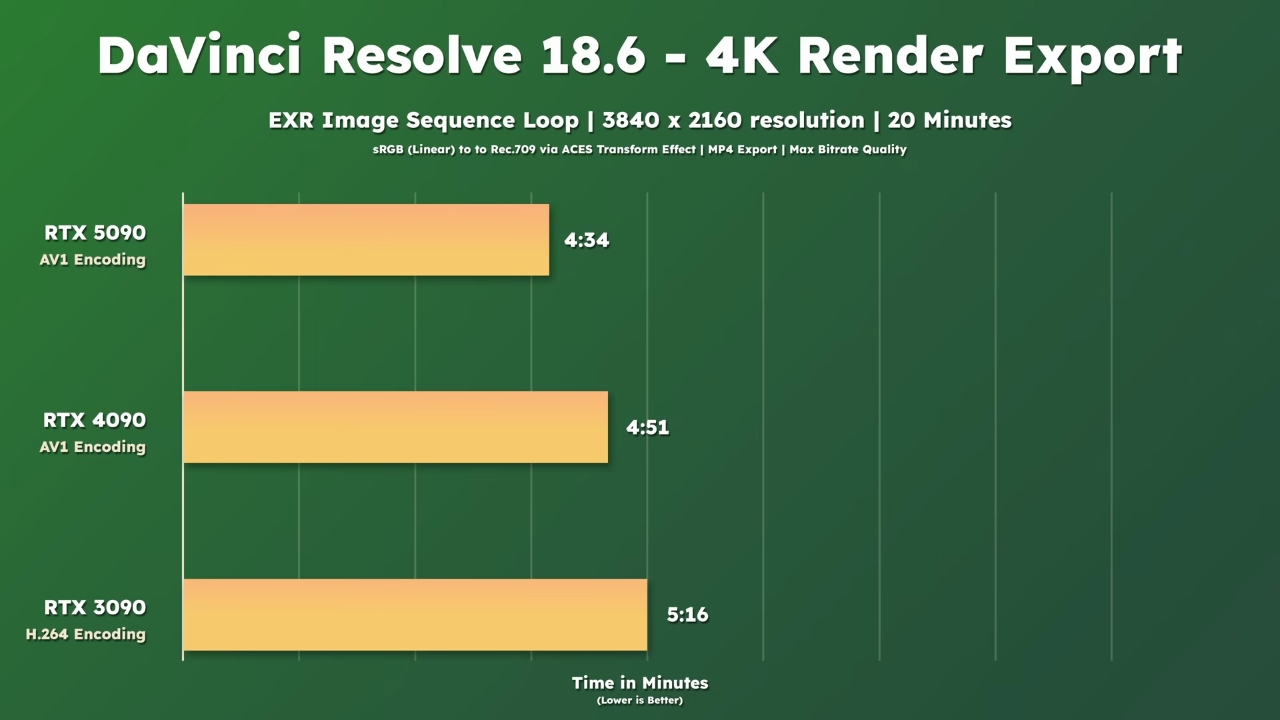
Davinci Resolve benchmark score from Sir Wade Neistadt
In our DaVinci Resolve 18.6 4K render tests, the RTX 5090 outperformed the 4090 with a time of 4 minutes 34 seconds versus 4 minutes 51 seconds, an improvement of about 6%. Both GPUs take advantage of AV1 hardware encoding, which is more efficient than the H.264 encoding used by the RTX 3090, which took 5 minutes 16 seconds to complete the same task.
While the performance gap between the 5090 and 4090 is modest, the 5090 still offers the fastest export speeds, making it a solid choice for professionals working with high-resolution video and modern encoding workflows.
RTX 5090 vs 4090: Which Is Better for 3D Rendering in 2025?
And that’s the comparison and benchmark results when rendering on software with the two top cards RTX 5090 vs 4090.
Obviously, it’s no surprise that the new graphics card is better than the old one, so the answer to the question ‘Is RTX 5090 stronger than RTX 4090?’ is definitely ‘Yes’. If you are a technology lover, wanting to experience the most powerful performance, experience the latest graphics technology, then buying an RTX 5090 is definitely a thing to do. But if you already own an RTX 4090 card, is it worth upgrading to RTX 5090? Not so much.
In short, RTX 5090 is the better GPU for 3D rendering in 2025, especially for ray tracing tools like V-Ray, Arnold, and Unreal Path Tracing. And of course, if you don’t have a budget limit, then the RTX 5090 is definitely worth investing in. However, if your workflow doesn’t take full advantage of it or you’re looking for a better price/performance ratio, the RTX 4090 is still a more powerful and cost-effective choice, especially in mature or optimized workflows.
If you haven’t tried rendering with an RTX 4090 yet, give it a go on a render farm. It’s an easy way to test high-end performance and speed up your projects without needing to buy the hardware yourself.
Boost Your Rendering with iRender’s RTX 4090 Servers
iRender provides high-configuration servers that increase CPU and GPU rendering speeds. We offer the most powerful RTX 4090 configuration packages on the market, all equipped with AMD RyzenTM ThreadripperTM PRO 3955WX @ 3.9 – 4.2GHz and AMD Ryzen™ Threadripper™ PRO 5975WX @ 3.6 – 4.5GHz processors, 256GB RAM and 2T NVMe SSD hard drive capacity. With a wide range of GPU servers (1/2/4/6/8x) – RTX 3090/4090, you can choose the server that suits your needs to start the rendering process.
We are proud to support all popular 3D software, render engines, and plugins, including Redshift, Octane, V-Ray, Blender, Unreal Engine, and more.
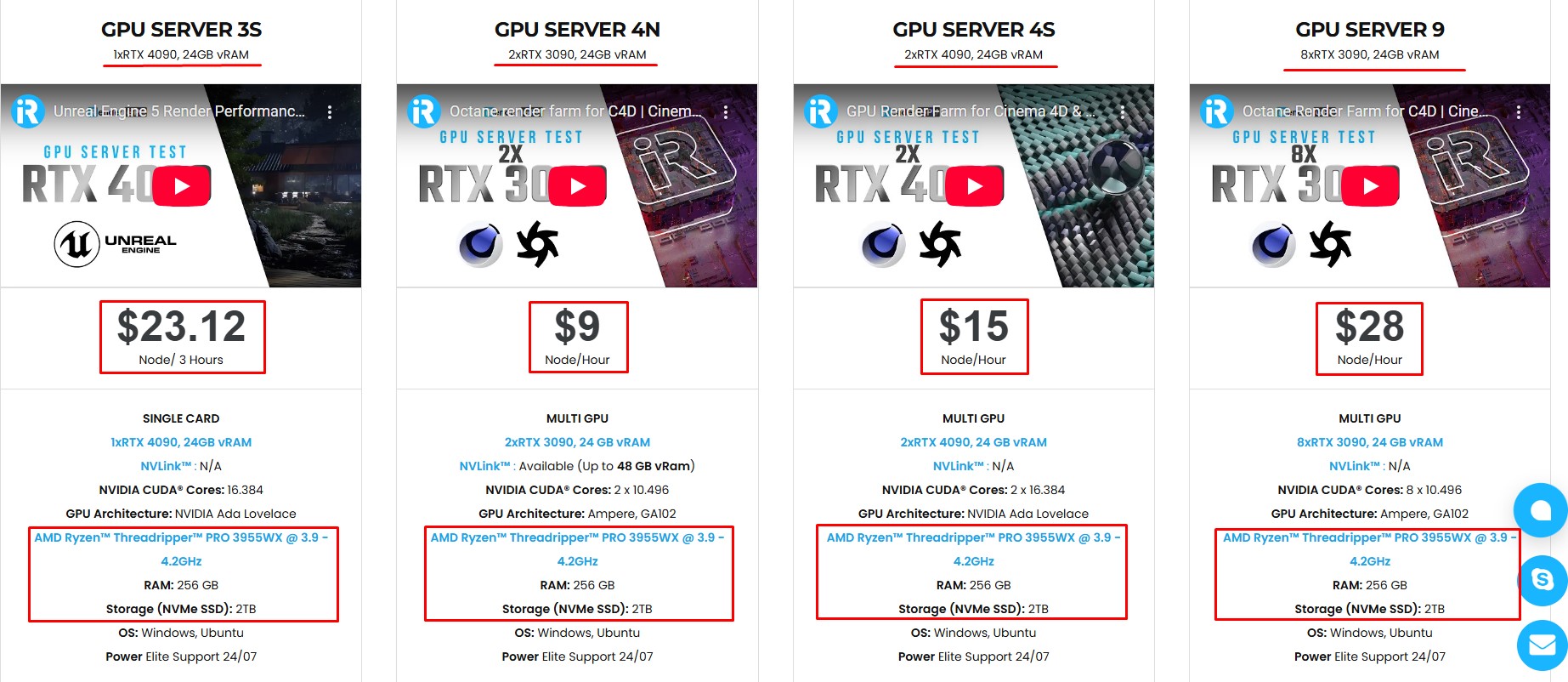
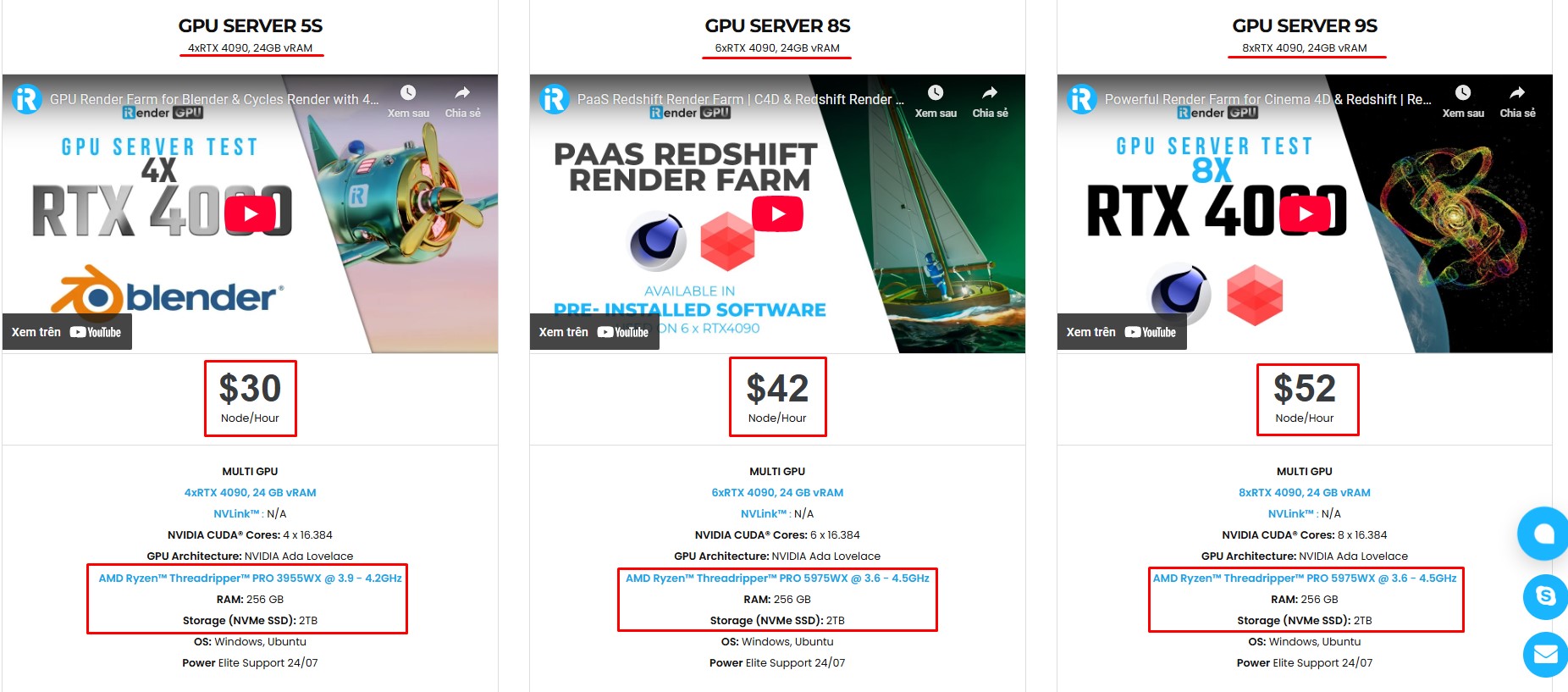
Simple Your Workflow with Software Preinstalled
Our servers have Blender, Cinema 4D and Redshift, Stable Diffusion preinstalled. Especially, we provide each user with one combo Cinema 4D and Redshift license for free.
You just need to transfer your files, connect to the remote machine, and activate our licenses. Then you can render yourself like the way you do on your local PC. Setting up ONCE and your working environment will be saved and ready to use at any time.
Why choose iRender?
Transferring data may cost time and money on the remote server. However, at iRender, you can totally upload and download your files without booting the server, then you can save a lot of money.
We have an iRender GPU app for Windows PC, which integrates all features and is easy to use, and an iRender Drive app for MacOS users to transfer data only. Moreover, there are many reasons why this is the best render farm for your project.
- 100% Software Support: We support all 3D software, their plugins, and render engines.
- Full Control: Our service will give you full control over the servers you rent. Therefore, you are free to create your own working environment.
- Go Green: We are committed to using 100% solar renewable energy towards environmental sustainability.
- Real-human 24/7 Support: Our professional support agents and technicians guarantee to bring you the best rendering experience.
Let’s see our latest performance test for C4D & Redshift, C4D & Octane, and Blender Cycles on our servers, you’ll definitely see the difference!
If you still wonder if this is the right place for your project, REGISTER NOW to get a trial and receive a 100% bonus promotion for your first transaction within 24 hours of registration with us.
This May, let’s celebrate our 6th anniversary with the biggest offer ever!
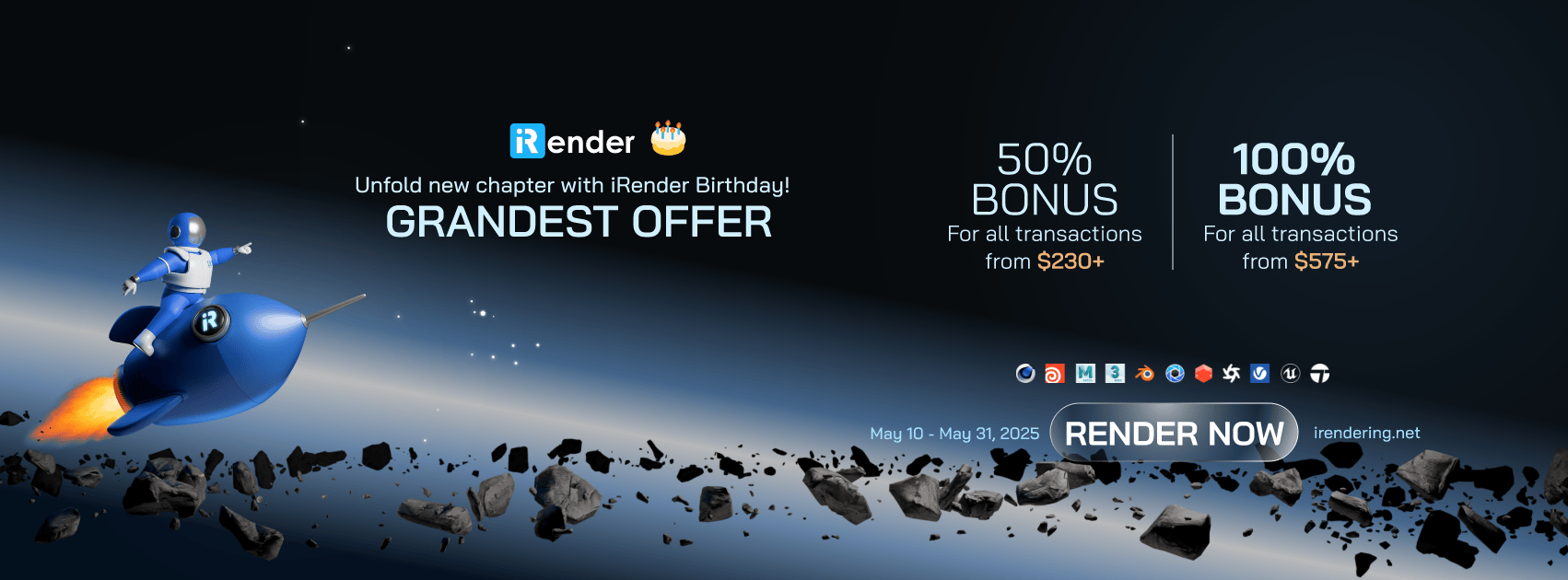
For more detailed information, please contact us via Live chat 24/7 or WhatsApp: +(+84) 912-785-500 or Email: [email protected]
iRender – Happy Rendering!
References: Sir Wade Neistadt, pugetsystems
Related Posts
The latest creative news from Cinema 4D Cloud Rendering , V-Ray Cloud Rendering , Redshift Cloud Rendering, Octane Cloud Rendering, 3D VFX Plugins & Cloud Rendering.


